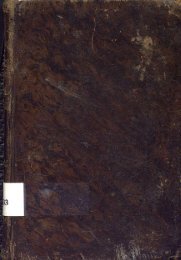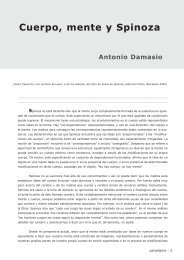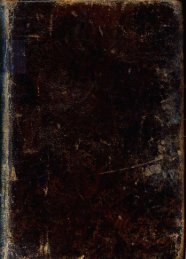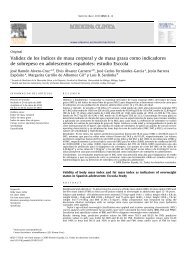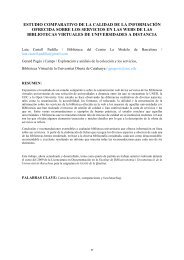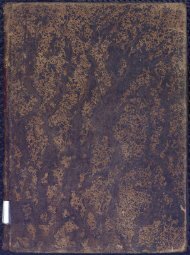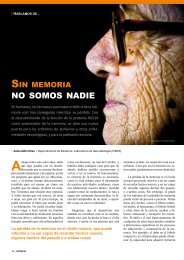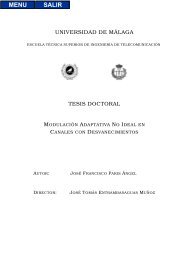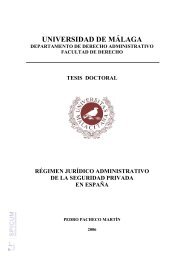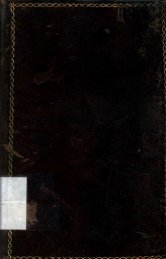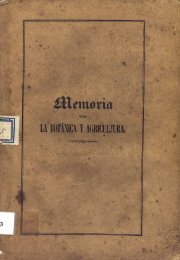Papel de las actividades superóxido dismutasa y catalasa en la ...
Papel de las actividades superóxido dismutasa y catalasa en la ...
Papel de las actividades superóxido dismutasa y catalasa en la ...
Create successful ePaper yourself
Turn your PDF publications into a flip-book with our unique Google optimized e-Paper software.
Journal of Fish Diseases 2006, 29, 355–364<br />
PDíaz-Rosales et al. Superoxi<strong>de</strong> dismutase and cata<strong><strong>la</strong>s</strong>e in P. damse<strong>la</strong>e ssp. piscicida<br />
number of bacteria nee<strong>de</strong>d to kill 50% of the<br />
inocu<strong>la</strong>ted fish (Reed & Mü<strong>en</strong>ch 1938). Strain<br />
Lg h41/01 with an LD 50 ¼ 2.8 · 10 4 cfu g )1 fish<br />
was consi<strong>de</strong>red virul<strong>en</strong>t for sole and strain EPOY-<br />
8803-II with LD 50 > 7.7 · 10 6 cfu g )1 fish was<br />
consi<strong>de</strong>red non-virul<strong>en</strong>t.<br />
Bacterial growth conditions<br />
Bacteria were stored at )80 °C in tryptic soy broth<br />
(TSB; Oxoid Ltd., Basingstoke, UK) containing<br />
2% NaCl and 20% glycerol. Bacteria were cultured<br />
on tryptic soy agar (TSA; Oxoid) containing 2%<br />
NaCl and incubated at 22 °C for 48 h. One colony<br />
was used to inocu<strong>la</strong>te 5 mL TSBs and incubated for<br />
18 h at 22 °C with shaking. Aliquots (25 lL) of<br />
these cultures were used to inocu<strong>la</strong>te 250 mL TSBs<br />
which was incubated at 22 °C with shaking. The<br />
incubation time varied <strong>de</strong>p<strong>en</strong>ding on the culture<br />
condition and strain to be assayed.<br />
Differ<strong>en</strong>t growth conditions were assayed to<br />
<strong>de</strong>termine the pot<strong>en</strong>tial induction of SOD and<br />
cata<strong><strong>la</strong>s</strong>e activities. Thus, 250-mL culture f<strong><strong>la</strong>s</strong>ks were<br />
supplem<strong>en</strong>ted with an iron che<strong>la</strong>nt, dipyridyl<br />
(100 lm), FeCl 3 Æ6H 2 O (100 lm) or MnSO 4 Æ2H 2 O<br />
(250 lm) to <strong>de</strong>termine the influ<strong>en</strong>ce of iron and<br />
manganese avai<strong>la</strong>bility on <strong>en</strong>zymatic activity. In<br />
or<strong>de</strong>r to induce oxidative stress, methyl violog<strong>en</strong><br />
(0.2 mm), which g<strong>en</strong>erates superoxi<strong>de</strong> radicals, was<br />
ad<strong>de</strong>d to mid-expon<strong>en</strong>tial cultures, which were th<strong>en</strong><br />
incubated for 8 h before c<strong>en</strong>trifugation. The<br />
pot<strong>en</strong>tial induction of <strong>en</strong>zymatic activities by<br />
hydrog<strong>en</strong> peroxi<strong>de</strong> was tested in cultures after the<br />
addition of two pulses of hydrog<strong>en</strong> peroxi<strong>de</strong>, one of<br />
20 lm in the mid-expon<strong>en</strong>tial phase, and another of<br />
2mm in the early stationary phase. Cells were<br />
harvested after 1-h incubation. The influ<strong>en</strong>ce of the<br />
growth phase was investigated with bacteria harvested<br />
from mid-expon<strong>en</strong>tial (OD 600 ¼ 0.4–0.6) and<br />
early stationary (OD 600 ¼ 1–1.2) phase cultures.<br />
Preparation of cru<strong>de</strong> extracts<br />
Bacteria were harvested from cultures grown as<br />
<strong>de</strong>scribed above by c<strong>en</strong>trifugation at 2000 g for<br />
20 min at 4 °C and washing twice in 25 mm<br />
potassium phosphate buffer containing 1 mm disodium<br />
ethyl<strong>en</strong>e diamine tetraacetic acid (EDTA;<br />
Sigma-Aldrich, St. Louis, MO, USA), pH 7.2 and<br />
0.5 mm ph<strong>en</strong>yl methylsulphonyl fluori<strong>de</strong> (Sigma)<br />
followed by re-susp<strong>en</strong>sion in 1 mL of the same<br />
buffer. Susp<strong>en</strong>sions were sonicated on ice for 120 s<br />
(four pulses of 30 s with 15 s cooling betwe<strong>en</strong><br />
bursts). Lysates were c<strong>la</strong>rified twice by c<strong>en</strong>trifugation<br />
at 10 000 g for 20 min at 4 °C. Supernatants<br />
were assayed for the <strong>de</strong>tection of SOD and cata<strong><strong>la</strong>s</strong>e<br />
and quantification of <strong>en</strong>zymatic activity on acry<strong>la</strong>mi<strong>de</strong><br />
gels. Total protein conc<strong>en</strong>tration was <strong>de</strong>termined<br />
by the method of Bradford (1976) using<br />
bovine serum albumin as standard.<br />
Polyacry<strong>la</strong>mi<strong>de</strong> gel electrophoresis<br />
Electrophoresis was performed in non-<strong>de</strong>naturing<br />
discontinuous polyacry<strong>la</strong>mi<strong>de</strong> mini-gels using the<br />
Bio-Rad Mini Protean II System (Bio-Rad Laboratories,<br />
Richmond, CA, USA) with a 10% acry<strong>la</strong>mi<strong>de</strong>/bis<br />
separating gel (1.5 m Tris–HCl, pH 8.8)<br />
and a 4% acry<strong>la</strong>mi<strong>de</strong>/bis stacking gel (0.5 m Tris–<br />
HCl, pH 8.3). The extracts in the sample buffer<br />
were applied to the gel at a conc<strong>en</strong>tration of<br />
20–24 lg protein per <strong>la</strong>ne. Gels were th<strong>en</strong> stained<br />
for SOD or cata<strong><strong>la</strong>s</strong>e and peroxidase activities.<br />
Detection and quantification of SOD activity<br />
Superoxi<strong>de</strong> dismutase activity was visualized on gels<br />
by nitroblue tetrazolium (NBT; Sigma) negative<br />
staining (Beauchamp & Fridovich 1971). Briefly,<br />
gels were washed in distilled water, soaked in a<br />
solution of 2.45 mm NBT for 20 min, followed by<br />
10-min incubation in darkness in a solution<br />
containing 50 mm potassium phosphate buffer<br />
(pH 7.2), 0.028 mm ribof<strong>la</strong>vin (Sigma) and<br />
28 mm tetramethylethyl<strong>en</strong>ediamine (TEMED;<br />
Sigma). Gels were illuminated on a light box to<br />
<strong>de</strong>velop a dark background with achromatic bands<br />
corresponding to SOD activity, due to inhibition of<br />
the photochemical reduction of NBT to formazan<br />
blue.<br />
The method employed to quantify SOD activity<br />
is based on the ability of SOD to inhibit the<br />
reduction of NBT by superoxi<strong>de</strong> (Winterbourn,<br />
Hawkins, Brian & Correll 1975; Worthington<br />
Enzyme Manual 1993). One unit is <strong>de</strong>fined as the<br />
amount of <strong>en</strong>zyme causing half the maximum<br />
inhibition of NBT reduction. Differ<strong>en</strong>t volumes of<br />
extracts were ad<strong>de</strong>d to cuvettes containing 0.2 mL<br />
of a solution of 0.1 m EDTA, 0.3 mm sodium<br />
cyani<strong>de</strong> (NaCN; Sigma) and 0.1 mL of 1.5 mm<br />
NBT. Th<strong>en</strong>, 0.05 mL of 0.12 mm ribof<strong>la</strong>vin was<br />
ad<strong>de</strong>d at zero time and at timed intervals. All<br />
cuvettes were incubated in a light box for 12 min<br />
and absorbance at 560 nm was read at timed<br />
Ó 2006<br />
B<strong>la</strong>ckwell Publishing Ltd<br />
357



